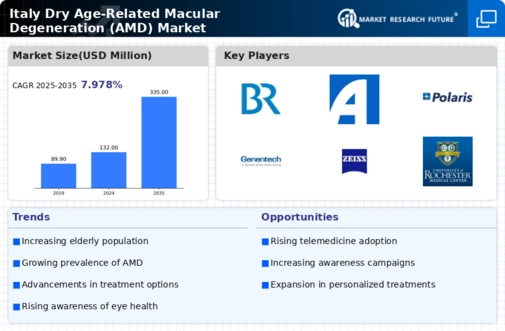Increasing Aging Population
The demographic shift towards an older population in Italy is a primary driver for the dry age-related-macular-degeneration-amd market. As the population aged 65 and above continues to grow, the prevalence of age-related eye diseases, including dry AMD, is expected to rise. Current estimates suggest that approximately 25% of individuals over 75 years old may experience some form of AMD. This increasing incidence creates a heightened demand for effective treatment options and management strategies within the dry age-related-macular-degeneration-amd market. Furthermore, the aging population necessitates greater healthcare resources and services, thereby driving investments in research and development of innovative therapies. Consequently, stakeholders in the healthcare sector are likely to focus on addressing the needs of this demographic, which could lead to significant growth opportunities in the market.
Rising Healthcare Expenditure
Italy's healthcare expenditure has been on an upward trajectory, which positively influences the dry age-related-macular-degeneration-amd market. With the government allocating more funds towards healthcare services, there is an increased focus on preventive care and treatment for chronic conditions, including AMD. In 2023, healthcare spending in Italy reached approximately €200 billion, with a significant portion directed towards ophthalmology. This trend indicates a growing recognition of the economic burden posed by vision impairment and the need for effective interventions. As healthcare budgets expand, there is a potential for enhanced access to advanced diagnostic tools and treatment options for patients suffering from dry AMD. This increased investment in healthcare infrastructure may also foster collaborations between public and private sectors, further propelling the growth of the dry age-related-macular-degeneration-amd market.
Advancements in Diagnostic Technologies
The dry age-related-macular-degeneration-amd market is significantly influenced by advancements in diagnostic technologies. Innovations such as optical coherence tomography (OCT) and fundus photography have improved the accuracy and speed of AMD diagnosis. These technologies enable healthcare professionals to detect early signs of dry AMD, facilitating timely intervention and management. In Italy, the adoption of these advanced diagnostic tools is likely to increase, as healthcare providers seek to enhance patient outcomes. Moreover, the integration of artificial intelligence in diagnostic processes may further streamline the identification of AMD, potentially leading to earlier treatment initiation. As diagnostic capabilities improve, the dry age-related-macular-degeneration-amd market may experience growth driven by increased patient awareness and proactive management of the disease.
Growing Research and Development Initiatives
The dry age-related-macular-degeneration-amd market is propelled by a surge in research and development initiatives aimed at understanding and treating the condition. Italian research institutions and pharmaceutical companies are increasingly investing in clinical trials and studies focused on novel therapies for dry AMD. Recent data indicates that over 50 clinical trials related to AMD are currently underway in Italy, exploring various treatment modalities, including gene therapy and anti-inflammatory agents. This robust research landscape suggests a commitment to advancing knowledge and developing effective solutions for patients. As new therapies emerge from these initiatives, the dry age-related-macular-degeneration-amd market is likely to expand, offering patients more options for managing their condition and improving their quality of life.
Increased Patient Advocacy and Support Groups
The rise of patient advocacy and support groups in Italy plays a crucial role in shaping the dry age-related-macular-degeneration-amd market. These organizations work to raise awareness about AMD, educate patients, and provide resources for those affected by the condition. By fostering a community of support, these groups empower patients to seek timely medical attention and adhere to treatment regimens. The presence of such advocacy initiatives may lead to increased demand for healthcare services and products related to dry AMD. Furthermore, as these groups collaborate with healthcare professionals and policymakers, they can influence funding and research priorities, ultimately benefiting the dry age-related-macular-degeneration-amd market. This growing network of support is likely to enhance patient engagement and drive market growth.





















Leave a Comment